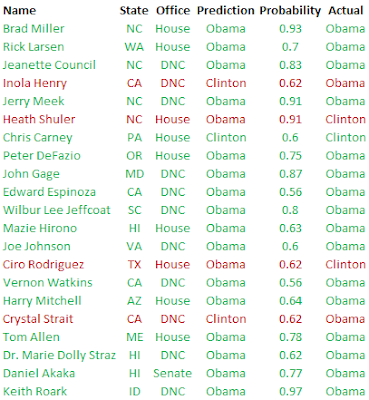"You have done great work with your superdelegate predictions. However, I think I have a model that I would bet a buck will outperform your model going forward: Model definition: if (superdelegate), then prediction = Obama"
The email was funny, particularly since I had already been mulling over whether to continue generating predictions for this very reason. Since Obama's big win in North Carolina, 21 previously unpledged superdelegates have made endorsements (not including add-ons). You can see the names along with our predictions here:

As you can see, we've gotten 17 out of these 21 endorsers (81%) correct. This would generally be very good for the model, which has usually hovered around a 70% accuracy rate since we started generating the predictions in early February. However, 81% isn't so good once you realize that if somebody had guessed that everyone was going to endorse Obama, he/she would have gotten 18 right (86%). This clearly reflects the status of the Democratic nomination race at this point: it doesn't take a statistical model to estimate what the remaining undeclared superdelegates will do at this point.
Just for fun, I did add the newly committed superdelegates to our dataset along with a variable capturing the change in dynamics after the May 6th primaries. The predictions generated by the model appear to largely match reality. There are only 31 superdelegates left on the Clinton side of the distribution with most siding with Obama:
 Of course, it is hard to say that even the few superdelegates falling on the right side of the distribution will actually endorse Clinton now. In short, unless something changes, from here on out I'd also take our reader's model over the one we have been using.
Of course, it is hard to say that even the few superdelegates falling on the right side of the distribution will actually endorse Clinton now. In short, unless something changes, from here on out I'd also take our reader's model over the one we have been using.We began generating these predictions on February 8th and 9th. The idea behind the model at the time was to examine whether one candidate was likely to pick up more superdelegate support than the other over the coming weeks and months. Our underlying assumption was that superdelegates were politicians who were accountable to various constituencies. As such, we believed that their behavior would be relatively predictable. Based on those first predictions, I wrote:
"The pattern in the figure is pretty clear: our model estimates that there are a lot more unpledged superdelegates who are likely to support Obama over Clinton than vice versa. In fact, the Obama advantage is about 2 to 1. This is significant since Obama presently trails Clinton by nearly 100 superdelegates."
Indeed, three months later, it appears that our predictions were borne out. Obama has now passed Clinton in superdelegates just as we have always predicted he eventually would.
Despite the fact that the model seems unnecessary at this point, I will continue to update the data and check how we are doing from time to time. And if something changes in the contest and superdelegate endorsements are again up for grabs, we will be ready to jump right back into business. But, for now, I will be spending much less time focusing on the model.
I want to thank the Democratic Convention Watch website for supporting our efforts to generate these predictions and for maintaining such helpful information on the superdelegates. I also want to thank Alicia Prevost and Caitlin Zook at CCPS for working hard to collect the data we used in the model. And I definitely want to show my appreciation for all of the readers who posted comments that helped us refine and tweak the model.
For those of you who missed out on all the superdelegate prediction fun over the past few months, check out the archives of this blog and see Carl Bialik's post on it here.

No comments:
Post a Comment